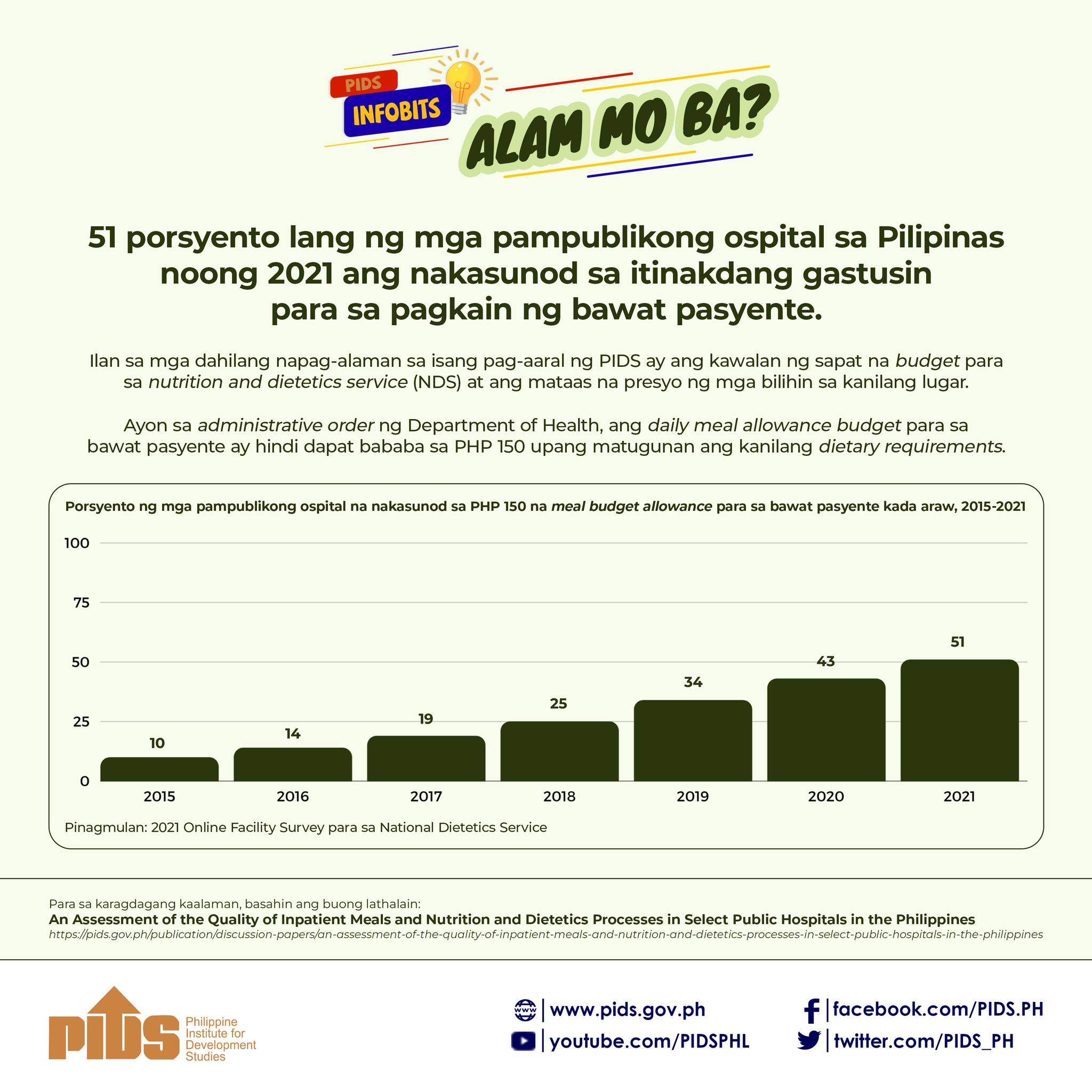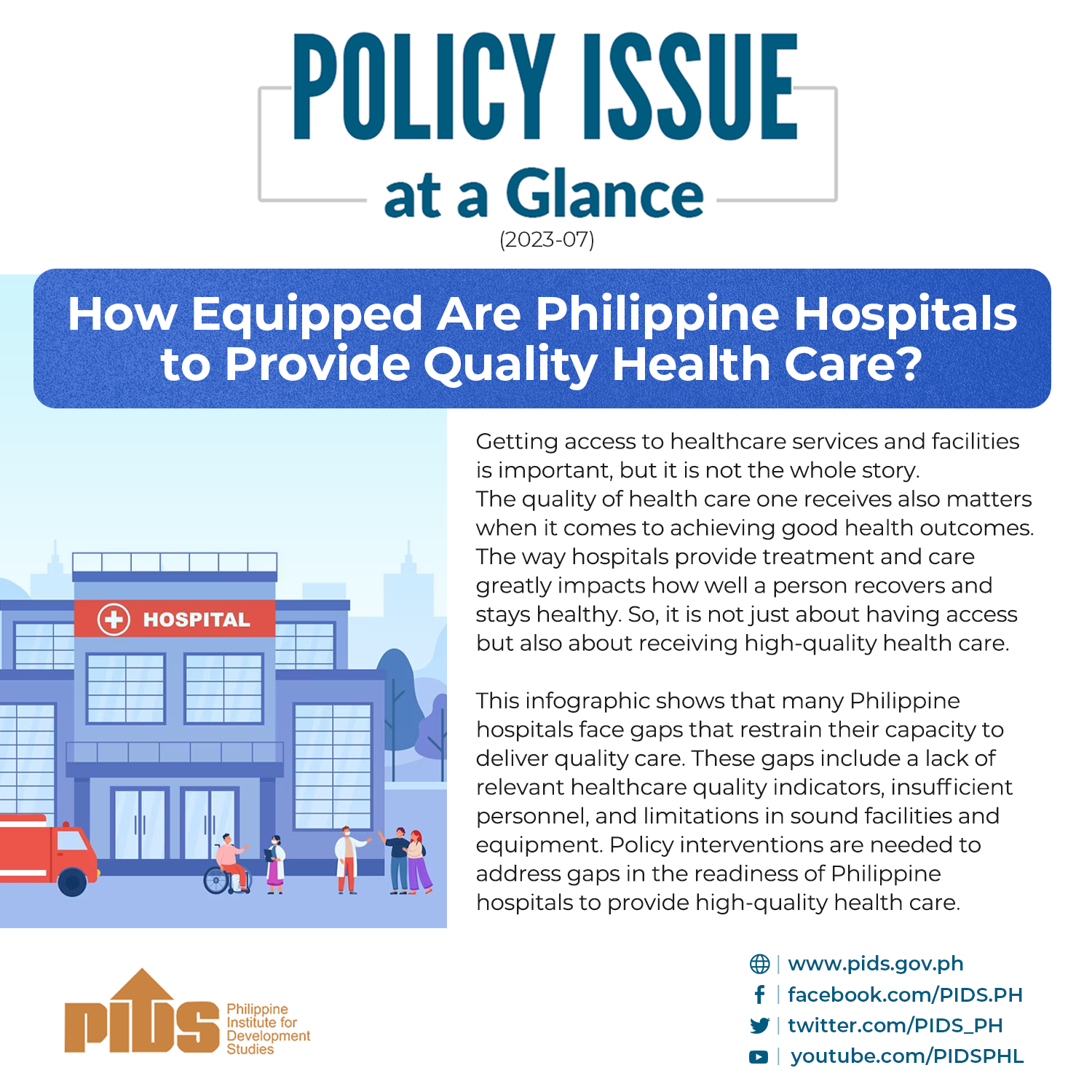The challenges identified in the government’s Health Facilities Enhancement Program (HFEP) should be addressed to speed up the construction and equipping of health facilities (hospitals and health centers) which in turn can have a far greater impact for the benefit of Filipinos especially the poor, a report released by the Philippine Institute for Development Studies (PIDS) said.
The PIDS policy note – Do capital investments in health increase local service utilization? – said while HFEP has been found to have a positive impact on the utilization of local health services, its implementation has been highly problematic.
“One of the problems identified is the inadequacy of HFEP funding that necessitated local governments to contribute their own funds to complete the construction of facilities,” the report said.
“Another problem is prolonged construction (average of three to four years) due to lack of budget, the need to delay construction so as not to disrupt hospital and rural health unit (RHU) operations, or delays on the part of the contractors as they are involved in multiple projects,” it added.
The PIDS study said about 71.4 percent of the 260 HFEP infrastructure projects were completed as of December 2015. Of the completed projects, 90.9 percent are functional.
The report said despite the immense difficulties in implementing HFEP, it is clear that the utilization of services provided by recipient health facilities increased.
“Unequivocally, those hospitals and infirmaries that received HFEP investments showed higher volume of services than those that did not,” the paper said.
“Moreover, the volume of services was higher after the completion of the HFEP projects compared to before and during HFEP. Thus, this descriptive analysis shows that HFEP had a demonstrable impact in increasing the volume of services in hospitals and infirmaries, although the results were less clear for RHUs and city health offices (CHOs),” it added.
The HFEP was implemented by the Aquino administration starting 2010 to address the major shortcoming in the Philippine healthcare system, since the stock of hospitals and health centers in the Philippines has barely increased and kept pace with population growth for nearly a generation since the 1970s.
The policy note cited data from the Department of Health’s Bureau of Health Facilities Development which showed that from 2010 to 2014, HFEP funded a total of 1,199 hospitals and infirmaries with an aggregate infrastructure funding of P11.7 billion, and a total of 2,968 RHUs and CHOs with an aggregate infrastructure funding of P5.2 billion.
Total HFEP infrastructure funding for the period reached P16.9 billion, or roughly P3.4 billion a year.
“However, the average funding per health facility is small: only P9.8 million per hospital/infirmary and P1.8 million per RHU/CHO,” the paper said.
The report said for the same period, HFEP funded the purchase of medical equipment for a total of 1,092 hospitals and infirmaries at an aggregate cost of P6.3 billion, and a total of 3,154 RHUs and CHOs at an aggregate cost of P2.9 billion.
HFEP medical equipment funding for the period reached P9.2 billion, or roughly P1.8 billion a year.//
The PIDS policy note – Do capital investments in health increase local service utilization? – said while HFEP has been found to have a positive impact on the utilization of local health services, its implementation has been highly problematic.
“One of the problems identified is the inadequacy of HFEP funding that necessitated local governments to contribute their own funds to complete the construction of facilities,” the report said.
“Another problem is prolonged construction (average of three to four years) due to lack of budget, the need to delay construction so as not to disrupt hospital and rural health unit (RHU) operations, or delays on the part of the contractors as they are involved in multiple projects,” it added.
The PIDS study said about 71.4 percent of the 260 HFEP infrastructure projects were completed as of December 2015. Of the completed projects, 90.9 percent are functional.
The report said despite the immense difficulties in implementing HFEP, it is clear that the utilization of services provided by recipient health facilities increased.
“Unequivocally, those hospitals and infirmaries that received HFEP investments showed higher volume of services than those that did not,” the paper said.
“Moreover, the volume of services was higher after the completion of the HFEP projects compared to before and during HFEP. Thus, this descriptive analysis shows that HFEP had a demonstrable impact in increasing the volume of services in hospitals and infirmaries, although the results were less clear for RHUs and city health offices (CHOs),” it added.
The HFEP was implemented by the Aquino administration starting 2010 to address the major shortcoming in the Philippine healthcare system, since the stock of hospitals and health centers in the Philippines has barely increased and kept pace with population growth for nearly a generation since the 1970s.
The policy note cited data from the Department of Health’s Bureau of Health Facilities Development which showed that from 2010 to 2014, HFEP funded a total of 1,199 hospitals and infirmaries with an aggregate infrastructure funding of P11.7 billion, and a total of 2,968 RHUs and CHOs with an aggregate infrastructure funding of P5.2 billion.
Total HFEP infrastructure funding for the period reached P16.9 billion, or roughly P3.4 billion a year.
“However, the average funding per health facility is small: only P9.8 million per hospital/infirmary and P1.8 million per RHU/CHO,” the paper said.
The report said for the same period, HFEP funded the purchase of medical equipment for a total of 1,092 hospitals and infirmaries at an aggregate cost of P6.3 billion, and a total of 3,154 RHUs and CHOs at an aggregate cost of P2.9 billion.
HFEP medical equipment funding for the period reached P9.2 billion, or roughly P1.8 billion a year.//












